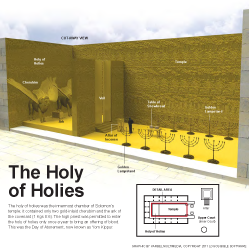5:1 was finished Solomon completed the temple approximately 960 bc. See 1 Kgs 7:51 and note.
Event | Date |
Solomon becomes king | 971 bc |
Solomon begins construction on the temple | 967 bc |
Solomon finishes the temple | 960 bc |
the holy objects of David his father Refers to the spoils of war collected by David (1 Chr 18:7–11).
into the storehouses of the house of God See 1 Chr 26:22–28; note on 26:26.
5:2–14 After completing the temple, Solomon’s first task is to bring the ark to the most holy place (holy of holies). While 2 Chronicles provides fewer details than 1 Kings about the temple’s construction and furnishings, it includes more information about moving the ark (compare 1 Kgs 8:1–11). This reflects the Chronicler’s emphasis on the temple as God’s dwelling place and the center of Israel’s worship. |
5:2 Solomon assembled Just as his father, David, did, Solomon gathers the leaders of Israel to move the ark, this time to its permanent residence (compare 1 Chr 13; 15).
the ark of the covenant of A wooden box or chest that contained the tablets of the law and symbolized Yahweh’s presence among the Israelites. See note on Exod 25:10.
5:3 the feast that is in the seventh month Refers to the Feast of Booths (Lev 23:33–44).
(Lev 23:33–44).
 Israelite Festivals Table
Israelite Festivals Table
5:4 and the Levites took up the ark Solomon ensures that the ark is carried in the proper way (see note on 1 Chr 15:2).
5:6 sacrificing sheep and cattle Just as it was with David, the processional of the ark was accompanied by sacrifices of worship (see 1 Chr 15:26).
5:7 the inner sanctuary of See 1 Kgs 6:5 and note.
the most holy place Compare Lev 16.
underneath the wings of the cherubim These cherubim are described in 2 Chr 3:10–13.
5:9 the ends of the poles See 1 Kgs 8:8 and note.
5:10 the two stone tablets Refers to the tablets on which the Ten Commandments were inscribed (Exod 34:1–5; Deut 10:1–5). Later tradition indicates that the ark also contained Aaron’s staff and a jar of manna (compare Heb 9:4).
5:11 sanctified themselves See note on Exod 29:1.
without keeping their divisions The Chronicler emphasizes the priests’ commitment to unity and worship.
5:12 all the Levitical singers See 1 Chr 25:1–31 and note.
Asaph, Heman, Jeduthun These same men led the worship when David moved the ark to Jerusalem (1 Chr 16:37, 42). David later appointed them as the temple musicians (1 Chr 25:1).
5:13 for he is good, because his loyal love is everlasting This refrain is part of the thanksgiving psalm sung when David brought the ark to Jerusalem (1 Chr 16:8–36 and note). The quotation here most likely reflects Psa 106:1, but the phrase is common throughout Psalms (e.g., Pss 107:1; 118:1; 136:1). See note on 2 Chron 1:8.
was filled with a cloud Just as He does in the wilderness, God appears in the temple as a cloud. See Exod 19:9 and note.
in the temple as a cloud. See Exod 19:9 and note.
 Theophany in the Old Testament
Theophany in the Old Testament
5:14 were not able to stand to minister See 1 Kgs 8:11 and note.

|
About Faithlife Study BibleFaithlife Study Bible (FSB) is your guide to the ancient world of the Old and New Testaments, with study notes and articles that draw from a wide range of academic research. FSB helps you learn how to think about interpretation methods and issues so that you can gain a deeper understanding of the text. |
| Copyright |
Copyright 2012 Logos Bible Software. |
| Support Info | fsb |
 Loading…
Loading…



